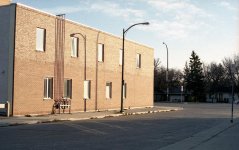pevelg
Well-known
I was out of 120mm film, so I took my dads FED5 with Kodak BW400 c41 film with me. Where did I go? The Renaissance festival!!! Yes, not the best place for B&W, but it is all I had. Anyways, lots of my pictures looked great, but some looked really weird. I am wondering what is going on. Here are examples.
Roll #1: This entire roll looked like this. Picture is of me and my little sister, parting before I get on a train. FED is sitting on a railing.

Roll # 2: The first photo looks horrid, the very next photo looks fine


Roll # 3: Same thing, first photo is horrible and the second photo after this one is horrid. The first photo is a fairy.


Am I just very bad at setting exposure? I thought that if I overexposed, everything would just be blown out, and if I under exposed things would be very dark. Whats up with this murky grey cast? BTW, I've only been shooting slides for a long time, but I never remember seeing anything like this, even when I occasionally shot color or B&W negatives on my M6ttl. Film was processed and scanned at Costco.
Roll #1: This entire roll looked like this. Picture is of me and my little sister, parting before I get on a train. FED is sitting on a railing.

Roll # 2: The first photo looks horrid, the very next photo looks fine


Roll # 3: Same thing, first photo is horrible and the second photo after this one is horrid. The first photo is a fairy.


Am I just very bad at setting exposure? I thought that if I overexposed, everything would just be blown out, and if I under exposed things would be very dark. Whats up with this murky grey cast? BTW, I've only been shooting slides for a long time, but I never remember seeing anything like this, even when I occasionally shot color or B&W negatives on my M6ttl. Film was processed and scanned at Costco.


